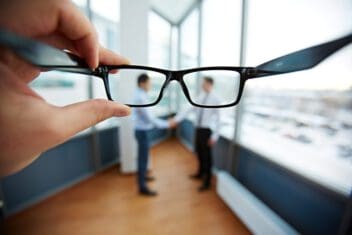The 10 Biggest Signs That You May Need Glasses
Home / Everything About Glasses /
Last Updated:
Table of Contents
With so many people wearing some form of corrective lenses, it may make you wonder if you could benefit from a pair yourself. If you are experiencing any common vision problems, it may be an indicator that you need glasses.
Glasses can correct many different vision problems, such as nearsightedness and farsightedness, and help people achieve 20/20 vision. While 20/20 vision doesn’t mean you have perfect vision, it is a requirement for many professions.
If you are considering getting glasses, you make an informed decision about what type of glasses you should be looking into if you know how they work. Different types of glasses, and particularly the lenses you select, are appropriate for different eye conditions. This can make a significant impact on how helpful your glasses are as well as how well your overall eye health is maintained.

How You Know if You Need Glasses
The American Academy of Ophthalmology suggests that nearly 150 million people in the United States use one or more types of corrective eyewear to enhance their vision. Typically, the need for glasses increases after 40 years as more people above this age bracket develop either farsightedness or nearsightedness. Blurry vision because of astigmatism affects up to 30% of Americans.
Refractive errors involving either the cornea or the lens are the leading contributors to poor vision. Fortunately, these problems including hyperopia, astigmatism, and myopia can be corrected conservatively by wearing lenses or through surgical interventions. So, how do you know if you need eyeglasses?
Every two years, you should have a comprehensive eye exam in a qualified doctor’s office to screen for any visual abnormalities. Some issues will be identified early enough and the appropriate treatment prescribed. Notwithstanding, some signs that you may require glasses include:
The 10 biggest signs that you may need glasses are:
- You are having trouble with blurry vision.
- You experience double vision.
- Objects appear fuzzy, and you can’t determine clearly defined lines.
- You experience headaches.
- You find yourself squinting often.
- In bright light, you often see halos or auras around objects.
- You experience eye strain.
- You have distorted vision.
- You have trouble seeing and driving at night.
- You’ve observed a change in your vision that you’re not happy with
Visual distortion manifested as any of the above-listed signs complicate normal functioning as usual items become difficult to identify and the risk of injury increases. Should you notice any negative changes in your vision, do not hesitate to seek optometric care.
What Situations Require 20/20 Vision?
The American Optometric Association explains that 20/20 vision refers to normal visual acuity, also known as clarity or sharpness of vision, as measured from a distance of 20 feet. Someone with 20/20 vision is able to see things clearly at 20 feet that should be able to be seen from that distance. For example, 20/40 vision means that you need to be 20 feet away from something to be able to see clearly what someone with normal vision could see from 40 feet away.
The following jobs require 20/20 vision:
- S. Air Force pilot
- Air traffic controller
- Airline pilot
- Firefighter
- Paramedics
- Astronauts
- Police officers
- Bus and taxi drivers
Each of the above professions has strict vision requirements as an additional measure of safety on the job. Vision that is 20/20 cannot guarantee that people employed in the above professions have perfect vision, but it does ensure that they can see objects clearly and sharply from appropriate distances.
Since people working in these professions often have other people’s lives in their hands, it is no wonder that perfectly sharp vision is a requirement.
How Do Glasses Work?

Glasses work by focusing light rays that you are not able to focus properly on your own. Normally, your eyes are able to collect light through your pupils and bend them correctly onto the retina at the back of your eye. When light rays are focused properly like this you have clear, sharp vision.
In people who were either born with or develop refractive vision problems, the cornea and lens of the eye no longer bend light the right way.
You deserve clear vision. We can help.
With 135+ locations and over 2.5 million procedures performed, our board-certified eye surgeons deliver results you can trust.
Your journey to better vision starts here.
People who are nearsighted, for example, have eyes that focus light just in front of the retina, while people who are farsighted have eyes that focus light just behind the retina. Glasses can help people with a variety of refractive vision issues by bending light before it reaches your eye. Your eye then bends light rays further, and the light is properly focused onto your retinas.
Prescription glasses allow people with varying degrees of refractive issues to benefit from corrective eyewear.
Different Types of Glasses
There are many types of glasses and lenses available to help people gain improved vision. While significant thought is often put into the fashion statement you want to make with your glasses frames, lenses play a far more important role in the effectiveness of your glasses.
Popular lenses and their appropriate uses include:
- Aspheric lenses. With a complex front surface that gradually curves from the center of the lens out to the edge, these lenses provide corrections for small vision distortions.
- Bifocal lenses. These lenses are able to adjust for nearsightedness and farsightedness in the same lens by having a top half designed for distance vision and a bottom half for near vision. People whose near vision has decreased with age are often prescribed bifocals.
- Trifocal lenses. Trifocals include the nearsighted and farsighted assistance provided by bifocals and also have a portion of the lens to help people see objects that are just a couple feet away.
- Progressive lenses. Progressives provide the focusing range that bifocal and trifocal lenses do without having lines that separate distinct sections, which make them more appealing for people concerned with the aesthetic aspects of their lenses.
- High-index lenses. These lenses are made with high-tech plastic. They allow people who require stronger prescriptions to wear lighter and more comfortable glasses than thick traditional glass lenses would allow.
- Photochromic lenses. Designed to automatically adjust to sunlight, these lenses can be applied to any prescription, lens design, or material. They are appropriate for people of all ages.
- Polarized lenses. Polarized lenses can help everyone wearing glasses, prescription or not, to maintain healthy eye sight by providing UV protection. People with particular sensitivity to light, those who just had cataract surgery, and those exposed to bright sunlight, even indoors, can benefit from polarized lenses.
- Polycarbonate lenses. A great option for active people and children who are looking for a resilient, impact-resistant lens, polycarbonate lenses are highly durable and have built-in UV filters.
Understanding the Need for Eyeglasses

Understanding your personal needs for eyeglasses and how different types of lenses can help you is essential to finding the right pair. Receiving a comprehensive eye exam from an eye care specialist is a great place to start to help you determine if you need glasses or not.
What Happens If I Need Glasses but Do Not Get Them?
While failure to wear the prescribed lenses does not cause further deterioration in your vision, it may give you considerable visual discomfort. The intensity of the symptoms will depend on the nature of your visual abnormality and age.
As an adult with blurry vision, your eyes will have to work harder trying to focus on items if you don’t put on glasses. Consequently, you might develop eyestrain and pain. Wearing corrective lenses helps you see clearly and prevent overworking your ocular muscles.
Children who require glasses but do not get them will have poor development of the eyes with associated short-term and long-term effects. Headaches and eyestrain are likely to occur immediately while crossed or lazy eyes plus learning disabilities may occur later in life.
You are also likely to develop double vision, dizziness, and nausea if you don’t wear glasses after a prescription. All these symptoms will affect your daily activities with the potential of causing accidents and injuries especially if you drive. With blurry vision, eyestrain and headaches, your performance at school and at work is bound to decline.
You deserve clear vision. We can help.
With 135+ locations and over 2.5 million procedures performed, our board-certified eye surgeons deliver results you can trust.
Your journey to better vision starts here.
References
- Eye Health Statistics. (2019). American Academy of Ophthalmology.
- How Do Glasses Help to Correct Your Vision? (July 2018). How It Works.
- Lens Overview. (2019). Vision Service Plan.
- Visual Acuity: What is 20/20 Vision? American Optometric Association.
- You Need Perfect Vision for These Jobs. (March 2015). Industrial Safety & Hygiene News.
- Fast Facts of Common Eye Disorders. (June 9, 2020). Centers for Disease Control and Prevention. Date fetched: August 5, 2020.
- Distorted Vision. (February 2, 2021). American Academy of Ophthalmology. Date fetched: August 5, 2021.
- What Does 20/20 Vision Mean? (January 8, 2020). American Academy of Ophthalmology. Date fetched: August 5, 2021.
- You need perfect vision for these jobs. (March 31, 2015). The Edinburgh Clinic. Date fetched: August 5, 2021.
This content is for informational purposes only. It may have been reviewed by a licensed physician, but is not intended to serve as a substitute for professional medical advice. Always consult your healthcare provider with any health concerns. For more, read our Privacy Policy and Editorial Policy.
